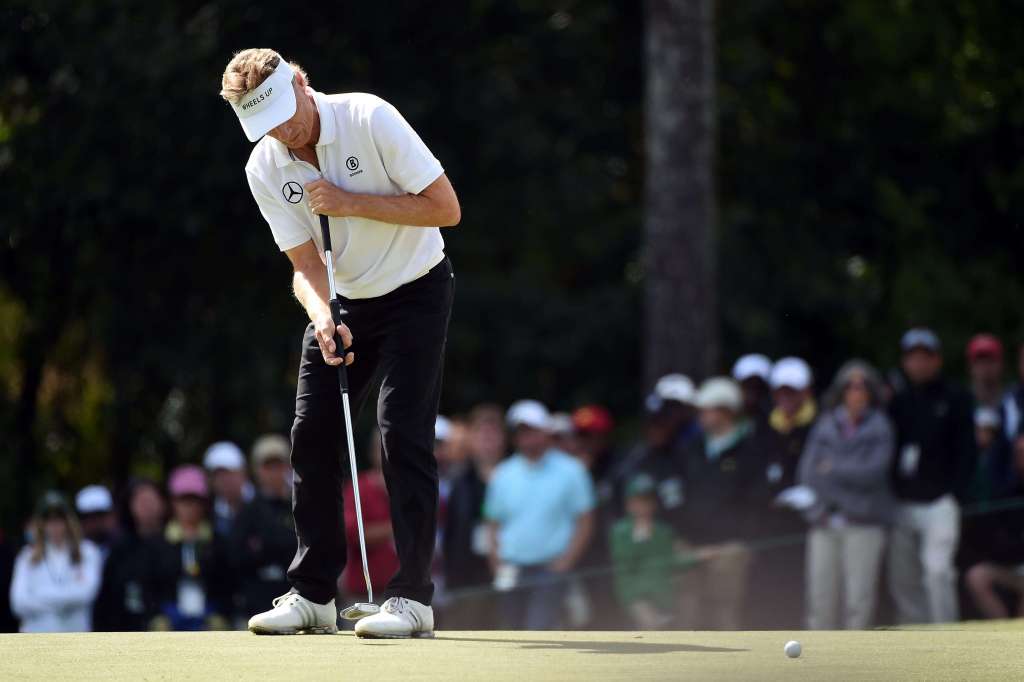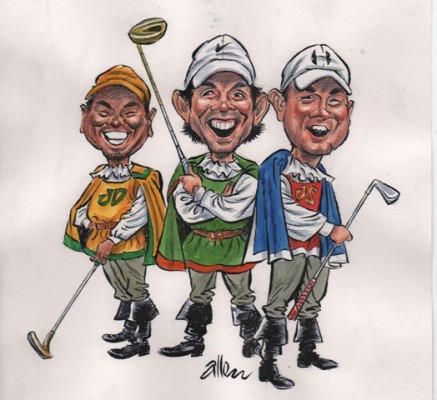In the Golf Paper
Peter Higgs – Why I was so glad that Langer failed

AUGUSTA, GEORGIA – APRIL 10: Bernhard Langer of Germany putts on the sixth green during the final round of the 2016 Masters Tournament at Augusta National Golf Club on April 10, 2016 in Augusta, Georgia. (Photo by Harry How/Getty Images)
One of the most appealing aspects of yet another memorable Masters was the sight of Bernhard Langer disappearing down the leaderboard on the final day.
Not that I have anything against Herr Langer personally, as he is a fine example of a hard-working sportsman who makes the most of his talents.
But, in case you didn’t notice or chose to forget, the German was wielding a broomhandle putter – the only man to do so following a crackdown on its use at the start of this year.
Langer’s putter was the elephant in the room at the 80th Masters. It was the implement that stuck out like the proverbial sore thumb, but the commentators chose to ignore it.
Yet what else could they do? They could hardly keep banging on about its surprise appearance when there was no apparent answer to what seemed to be an obvious wrong.
So the best solution was to treat the bloomin’ broomhandle like that damned elephant and pretend that it wasn’t there.
Now, after the dust has settled, we no longer need to take the blind-eye approach and can give serious consideration to an issue that cries out to be solved.
When I switched on my TV and saw Langer with the long putter, I was shocked and confused. There we were at the first Major since golf’s rulemakers made it difficult for players to continuing using the club in their accustomed style (from January 1, 2016), yet, in the hands of one of its most successful exponents, nothing seemed to have changed.
Although TV commentators made no initial reference to Langer’s putting stick it slowly emerged that the two-times
Masters champion had devised a method to avoid breaking the new ‘no-anchoring’ rule.
Although his practice stroke was illegal, we were told, he then eased his left (or top) hand millimetres away from his chest so that it was not touching and therefore not anchored. Although from TV and, as reporters at Augusta testified, it was difficult, if not impossible, to tell.
What would have happened if Langer had made contact with his chest during the stroke? Would he have called a penalty on himself as honest players do when a ball moves after they have addressed it? Or would it have been left to an eagle-eyed official to step in and create an embarrassing moment?
The problem lies in the fact that The R & A and the USGA did not actually ban the long putter but merely attempted to prevent it being used in the way that some professionals had done for years.
The vast majority took the hint and switched to a conventional putter with varying results. Adam Scott has proved there is life after the long putter by winning two tournaments in 2016 to move into the world’s top six. Others have found it harder to adapt but, at least in keeping with the aim of the new rule, have ditched the long putter – except Langer.
Suggestions that the new ruling could kill the career of Ernie Els, following his six-putt horror at Augusta, are surely wide of the mark. The South African admitted that he was against the long putter and switched to it only in desperation because others were doing so and he might as well join in.
Once the non-anchoring rule was announced, Els was one of the first to switch back to a conventional putter as he sought to conquer his demons. Now we wish him well in beating the ‘yips’ but not with an illegal method. Els would not want that for he knows that putting is an integral part of the sport.
The people to blame for this confusing mess are The R & A and the USGA, who fudged the issue of the long putter. The implement was a subject of controversy for years, leading to a lengthy debate that eventually resulted in the non-anchoring compromise.
They missed the chance. The long putter should simply have been banned. And then there would be no argument.
How can a club that is deemed to be too long for use in measuring the distance of a penalty or non-penalty drop (either one or two club lengths) then become legitimate for striking the ball? Either it’s illegal or it’s not.
Other clubs have been banned, in the past, the thin-faced driver and the two-sided chipper for example. But not the long putter.
So now we have a new Rule 14-1b that is being made to look foolish because Langer has found a loophole. Whether his minimal amendment to his putting stroke makes it less effective only he will know. But to the onlooker little, if anything, has changed.
Supporters of the long putter may think the former Ryder Cup captain is being defiant , resourceful and clever. Others may believe that he’s making a nonsense of the sport.
Take your pick.
But something must happen. Either Langer has to modify his method more so that he is not only not breaking the rule but can also BE SEEN to be not breaking the rule. Or the rule needs further amendment (preferably by banning the long putter completely).
If nothing is done, those broomhandle wielders who felt betrayed when the new rule was introduced will probably feel that their sacrifice has been a waste of time. And if they are struggling to adapt may ‘Do a Langer’, take up the long putter again and switch back to a method that is marginally different from the one they used for years. And then what would have been the point of the new rule?
In the meantime, don’t ask me to join the chorus of praise for a 58-year-old veteran being in contention at the start of the final round of the US Masters when something to my eyes clearly wasn’t right. And certainly don’t compare his achievement to that of Tom Watson, who came within a seven-foot putt (played with a conventional putter) of winning the 2009 Open Championship at the age of 59.
Thanks to Langer’s final round of 79 we didn’t have to.
Tagged Bernard Langer, Peter Higgs







